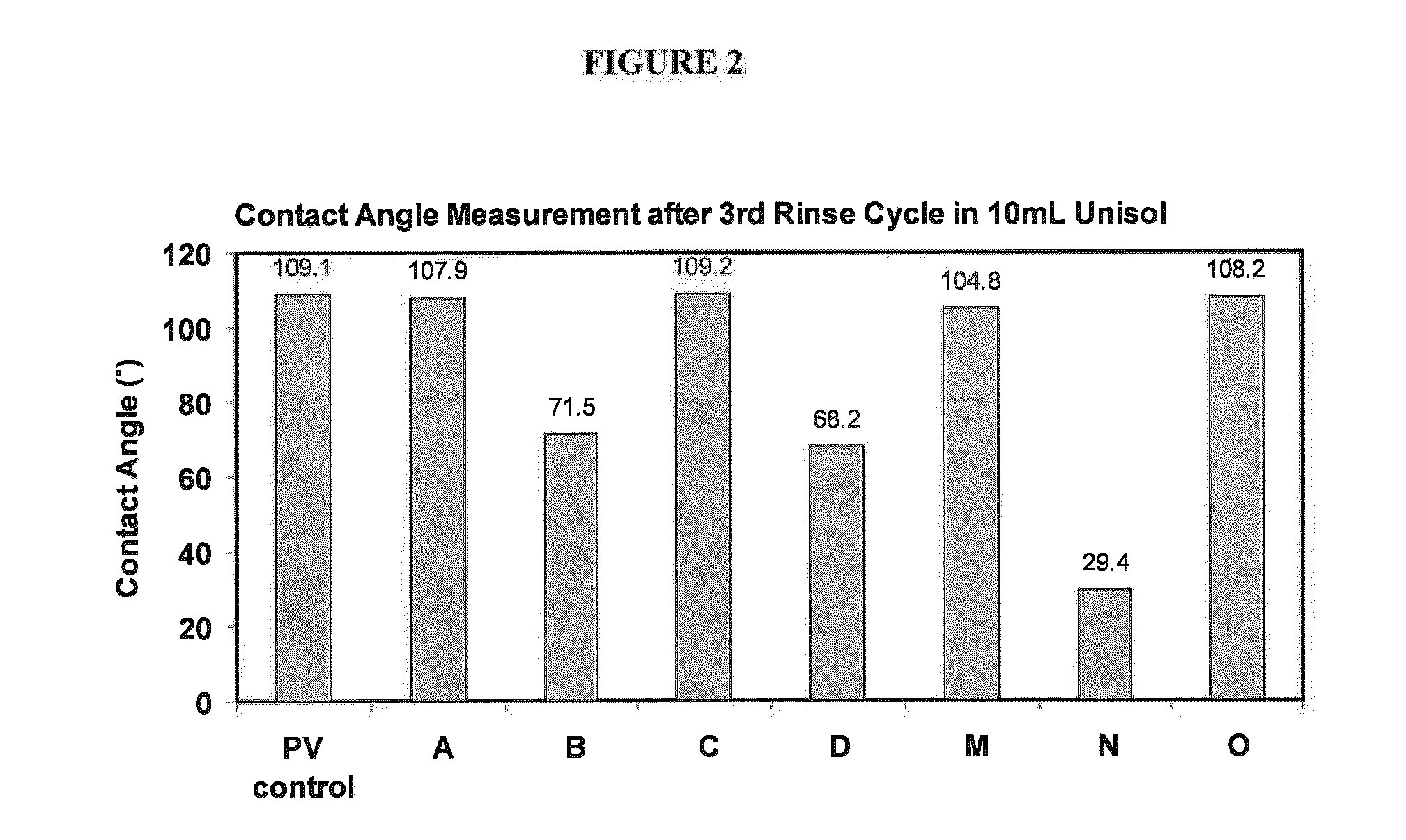Use of pbo-peo-pbo block copolymers in ophthalmic compositions
a technology of ophthalmic compositions and copolymers, which is applied in the field of ophthalmic compositions, can solve the problems of hydrogen peroxide used in disinfection, affecting cleaning, excessive foaming, etc., and achieves the effects of facilitating the wettability of the device and/or the cleaning of the devi
- Summary
- Abstract
- Description
- Claims
- Application Information
AI Technical Summary
Benefits of technology
Problems solved by technology
Method used
Image
Examples
example 1
[0075]A series of PBO-PEO-PBO copolymers were investigated for foaming and wettability studies. Block lengths were confirmed by NMR. The BO units were fixed at 3 and 6 units with EO units ranging from 9 to 182. The increase in EO is to provide improved wettability, measured through Contact Angle, without sacrificing increased foaming, measured by visualization of foaming during neutralization. The Molecular Weight (Mw), confirmed by GPC, ranged from 830 g / mol up to 8442 / mol.
TABLE 1Investigation of a series of PBO-PEO-PBOcopolymers for foaming and wettability.InvestigatedInvestigatedComponentMwFoamingWettabilityBO3EO9BO3830✓✓BO3EO14BO31050✓✓BO3EO22BO31402✓✓BO3EO45BO32414✓✓BO3EO90BO34394✓✓BO3EO136BO36418✓—BO3EO182BO38442✓✓BO6EO9BO61262✓—BO6EO14BO61482✓—BO6EO22BO61834✓—BO6EO45BO62846✓—BO6EO90BO64824✓—
A step-wise experimental testing procedure was followed, whereby the PBO-PEO-PBO copolymers were first tested for excessive foaming, and then those PBO-PEO-PBO copolymers that did not caus...
example 2
[0076]The contact angles for two silicone hydrogel lenses, AcuVue Oasys® (AO) (Johnson & Johnson Vision Care, Inc., Jacksonville Fla.) and Pure Vision® (PV) (Bausch & Lomb Inc., Rochester, N.Y.), were measured as described below. The results are reported in FIG. 1, which shows Contact Angle values after a 3rd rinse cycle in Unisol® preservative-free saline solution (Alcon Laboratories, Inc. Fort Worth, Tex.) for Pure Vision and Acuvue Oasys contact lenses in Clear Care® formulations modified with the addition of 0.2% PBO-PEO-PBO. Clear Care® was the control for both PV and AO lenses.
Contact Angle Measurements for Control Lenses: No Pre-Soaking
[0077]Two brands of silicone hydrogel contact lenses (AcuVue Oasys® and Pure Vision®), were soaked in Unisol® saline solution overnight to remove residual packing solution contaminants, prior to measuring the contact angles. The lenses were then pre-soaked for 24 hours in Unisol with 0.2% PBO-PEO-PBO. The contact angle of each lens was then mea...
example 3
[0090]A series of formulations consisting of 3.5% Peroxide, 0.75% Sodium Borate, 0.35% Boric Acid at pH of 7.9 after neutralization were prepared with selected surfactants. The PBO-PEO-PBO surfactants were added in combination with Pluronic 17R4 to investigate their combined foaming and wettability.
TABLE 3PBO-PEO-PBO's and Pluronic 17R4 investigated for foamingand wettability studies using borate buffered vehicle.InvestigatedFoaming UponInvestigatedComponentMwNeutralizationContact AngleBO3EO45BO32414✓✓BO3EO90BO34394✓—BO3EO136BO36418✓—BO3EO182BO38442✓✓Pluronic 17R42650✓✓
None of the borate buffered peroxide formulations using the PBO-PEO-PBO's in Table 3 foamed in the presence of PLURONIC 17R4 upon neutralization.
PUM
| Property | Measurement | Unit |
|---|---|---|
| molecular weight | aaaaa | aaaaa |
| molecular weight | aaaaa | aaaaa |
| concentration | aaaaa | aaaaa |
Abstract
Description
Claims
Application Information
 Login to View More
Login to View More - R&D
- Intellectual Property
- Life Sciences
- Materials
- Tech Scout
- Unparalleled Data Quality
- Higher Quality Content
- 60% Fewer Hallucinations
Browse by: Latest US Patents, China's latest patents, Technical Efficacy Thesaurus, Application Domain, Technology Topic, Popular Technical Reports.
© 2025 PatSnap. All rights reserved.Legal|Privacy policy|Modern Slavery Act Transparency Statement|Sitemap|About US| Contact US: help@patsnap.com



